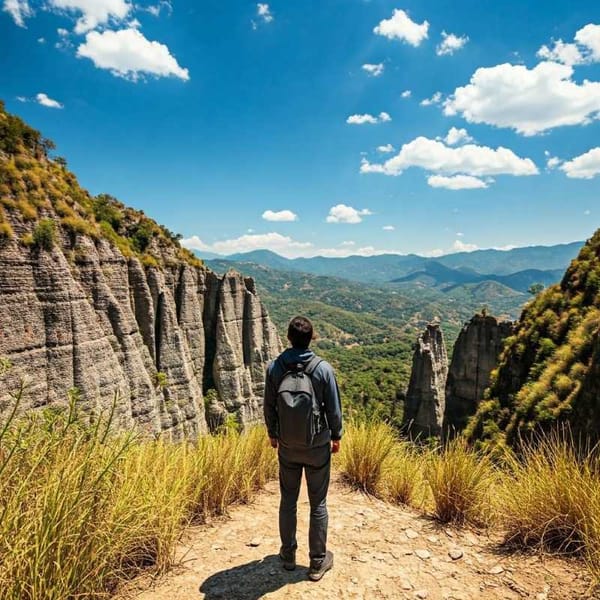How Green Criminology Fights for Mexico's Biodiversity
Mexico's biodiversity crisis demands a new approach: green criminology. Experts call for specialized laws, units, and public awareness to combat environmental crimes.

In the shadowed canyons and dust-choking deserts of Mexico, a different kind of war is being waged. It's not the familiar, headline-grabbing battles against cartels and corruption that typically define the nation in the global imagination. Instead, a quieter sort of revolution is taking root – a revolution led by scientists, researchers, and a growing movement of green criminologists determined to protect the land they love.
At the heart of this movement is Arturo Argueta Villamar, a researcher with UNAM's Socio-Environmental Studies Program. With the assured demeanor of a man accustomed to both the classroom and the field, Villamar draws a stark picture. “Mexico's environmental challenges are no less urgent than the violence tearing at our society,” he states. “We've faced down drug lords and kingpins, but against the destruction of our environment, traditional methods have fallen short.”
Villamar's words feel prophetic. Mexico's environmental problems are a tangled web: illegal logging decimates ancient forests; endangered species find their way onto the lucrative black market; pollution chokes rivers and coastal mangroves. Yet, in these dark shadows, Villamar and his peers see a glimmer of hope, and its name is…criminology?
A Different Kind of Criminal Profiling
For too long, the environmental movement has primarily been the domain of biologists, conservationists, lawyers, and activists. Their focus is on the damage – the felled trees, the polluted waters. But Villamar insists that to truly stop the destruction, we need to understand the destroyers. “Green criminology,” he explains, “doesn't just analyze the crime scene, it profiles the motives. Only then can we develop effective countermeasures.”
Imagine applying a Sherlock Holmes mindset to the environment. Green criminologists study the methods of illegal loggers like forensics teams analyze blood spatter. They trace the flow of trafficked animals, uncovering links and routes similar to narcotics investigations. They don't just identify damage; they predict, intervene, and advocate for change with the same tenacity traditionally focused on social crimes.
The shift isn't without its skeptics. Inés Arroyo Quiroz, a fellow researcher at UNAM, acknowledges the challenges: “Traditional criminologists need convincing, and understandably so. This is a complex new field, where even defining 'environmental crime' within the context of Mexico is a debate.” Yet, amidst the academic squabbles, a sense of common purpose, of urgency, drives this new movement.
Where Science Meets the Streets
The Third Interinstitutional Seminar on Green Criminology is where the theoretical meets the dirt under your fingernails. It's as likely to feature professors in button-downs as grizzled ecologists with binoculars slung around their necks. Lawyers exchange ideas with wildlife rehabilitators; economists brainstorm with veteran investigators. It's this unusual alliance that may prove Mexico's secret weapon.
The stakes couldn't be higher. Beyond the intrinsic value of a healthy environment, Mexico's unique biodiversity – the spiny armor of its cacti, the vibrant flash of its endangered birds – is an economic treasure. When criminals profit from ecological destruction, law-abiding communities, who often depend on ecotourism and the sustainable use of natural resources, are the ones who truly suffer.
Green criminology seeks to tilt the balance of power. It's an uphill battle, but then again, what fight for justice ever was easy? For the men and women on the frontlines of this ecological revolution, every rescued animal, every stretch of protected forest, every intercepted smuggling ring isn't just a victory; it's vindication of their quirky, sophisticated, and necessary approach.
Green Criminology Unmasks the Unseen
The rainforest shimmers, a dappled mosaic of green and gold. A jaguar, sleek and powerful, pads silently along a hidden trail. Somewhere unseen, a macaw lets out a raucous squawk, a splash of color against the vibrant foliage. It's a scene of dazzling natural beauty, but the tranquility belies a hidden menace.
Mexico, like many countries around the world, is locked in a fierce and often unseen struggle against environmental crimes – the “silent criminals” that leave a trail of destruction on its vast biodiversity. At the forefront of this battle is a developing field of research called green criminology, and Mexican researchers and stakeholders gathered recently for the Third Interinstitutional Seminar to grapple with the challenges posed by these insidious threats.
José Luis Carpio Domínguez of the Autonomous University of Tamaulipas, a member of the International Union for Conservation of Nature, paints a stark picture. Green criminology, he explains, focuses on documenting and understanding “illicit actions and crimes against biodiversity, ecosystems, and the life of the world.” The targets of these crimes are as varied as they are essential: endangered species poached for the exotic pet trade, forests illegally logged, waterways poisoned by pollutants…the list is heartbreakingly long.
The goal of this specialized field is more than academic interest. Green criminologists aim to provide scientific knowledge for the creation of effective public policies – strategies to protect Mexico's rich natural heritage and punish those who violate it.
Weakness in the Law
Yet, the legal framework to protect the environment and bring perpetrators to justice remains fraught with difficulties. José Ignacio Castro Salazar, of the Abasolo Higher Technological Institute, emphasizes the need to reform the penal code. Currently, many environmental crimes are classified as administrative offenses, resulting in little more than fines or temporary closures – mere slaps on the wrist for transgressions that may lead to irreversible damage.
“Greater administrative efforts are required,” Salazar insists. This includes creating an intelligence wing within the Federal Attorney General's Office for Environmental Protection and investing in specialized environmental prosecutors and experts to bolster legal action.
Even more alarmingly, Salazar highlights a sinister truth: environmental crimes can, over time, be deadlier than high-profile accidents. A contaminated river or polluted air might slowly cause widespread disease and death – a creeping threat often absent from the public's attention and far outside the reach of existing laws.
A Call for Action
The challenges faced by Mexico are not unique. Green crime is a global threat, a testament to the devastating consequences of human greed and indifference towards the natural world. Yet, the Third Interinstitutional Seminar on Green Criminology in Mexico is a sign of hope. It demonstrates the growing recognition of the gravity of these crimes, and the commitment to strengthening the tools available to combat them.
This gathering of experts is not just about talk. It's a focused assembly, aiming to chart a course towards practical solutions: stricter laws, better enforcement, and increased awareness. It's a testament to the fact that those who understand the devastating impact of green crime will not be silenced. Instead, their voices join a growing international chorus demanding a better future – a future where humans and the natural world can coexist, and where the “silent criminals” are no longer allowed to operate with impunity.




